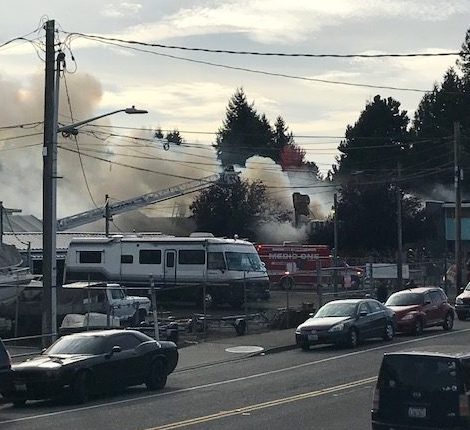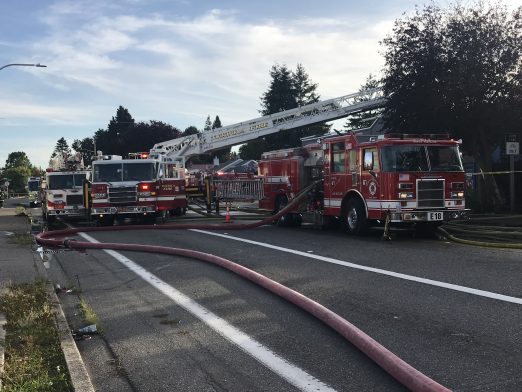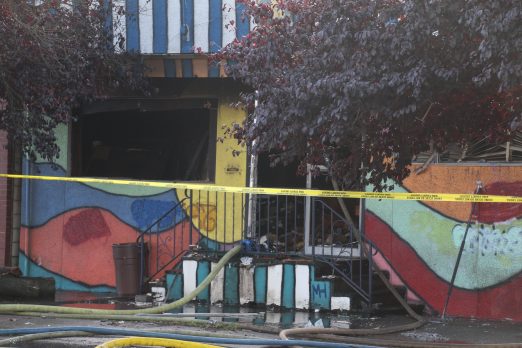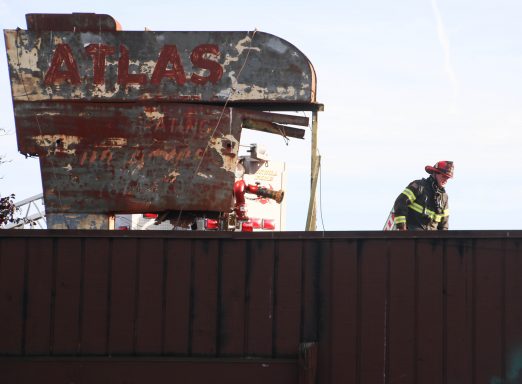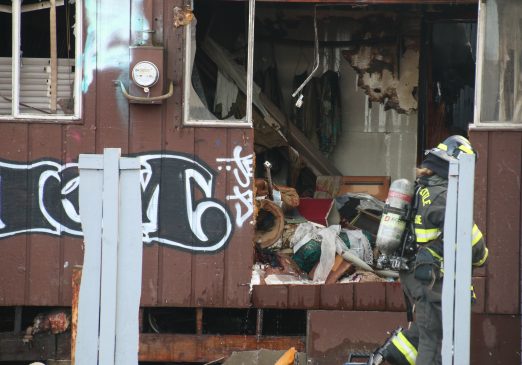
King County Sheriff Mitzi Johanknecht
Story and photos by Jason Grotelueschen
Reporting for White Center Now
Issues related to housing, zoning, crime, and safety took center stage Thursday night at the October meeting of the North Highline Unincorporated Area Council (NHUAC) at the North Highline Fire Station, featuring a visit from King County Sheriff Mitzi Johanknecht (who last appeared at NHUAC just over a year ago).
There was a good crowd at the meeting despite its overlap with the Seahawks game — in fact, while Johanknecht was speaking, a chorus of fireworks could be heard from around the neighborhood after the Seahawks’ victory, prompting chuckles and comments like “aren’t fireworks illegal?” from around the room.

Toplines from the meeting are below, including links to two surveys (one that closes October 13) for the public to share feedback:
NORTH HIGHLINE SUBAREA PLAN (website here): First on the agenda was David Goodman (pictured below), subarea planner from King County Department of Local Services, to give an update on the one-year North Highline Subarea planning process that began in July. Goodman said the planning is part of an effort to initiate new subarea plans across the county for various service areas such as North Highline. Plans include detailed assessments of the area’s land use, demographics, population and development. Goodman said the existing plans are very dated and haven’t changed in 25 years, and even those most recent changes from 1994 were limited to areas west of Highway 509 (east of 509, the plans are even older).

Goodman walked attendees though the area’s zoning map (digital version here) and explained that most of the area’s land (56.7%) was designated as “R-6-Residential” which means up to 6 dwelling units per acre. He noted that as part of the planning process, residents can “help decide what we want the community to look like in the future.”
NHUAC President Liz Giba and others in attendance asked about the White Center Community HUB project being planned at the former Public Health Center site at 8th Avenue SW & SW 108th Street (which could break ground in 2022 if things go according to plan), as well as the upcoming 2021 expansion of the RapidRide H Line (which will replace the extremely busy Metro Route 120). Goodman, along with other officials in attendance, answered audience questions about those initiatives and confirmed their importance as part of the overall vision and planning for the area.
Goodman said the planning process runs through next May and that his team plans to be back at NHUAC at least once more during that timeframe. In the meantime, he encouraged attendees to visit the project website and fill out their survey (click the “Take Our Survey” button) to share feedback. (Note: We had posted about this survey a couple of weeks ago as well.)
An audience member asked about ADU (accessory dwelling units) or “mother-in-law” dwellings. Goodman and other officials in attendance said that these are units which are 1000 square feet or smaller, not officially part of property it’s adjacent to, and without its own address. ADUs must be registered with the county.
WHITE CENTER MICROHOUSING DEMONSTRATION PROJECT: Next up was Mark Ellerbrook (pictured below), division director for King County Housing & Community Development, to give an update on plans for a WC-based Alternative Housing Demonstration Project (website here) that is currently in “public comment” period until October 13. Ellerbrook encouraged neighbors to give their feedback on the project by visiting its website.

The White Center project is one of two proposed sites in the area (the other is in Vashon Island) aimed at providing affordable housing options. Per their website, “the county started by asking: ‘What innovative housing types could create more affordable housing, but aren’t allowed under existing regulations?'” Ellerbrook said the projects aim to tackle two key issues:
- Housing crisis and availability of places to live. “Our estimate is that in the next 21 years we will need 240,000 additional units of affordable housing to meet demand and growth,” Ellerbrook said, adding that the median cost in King County is $1800/mo, and in order for citizens to be successful “we need housing of all types; what people want is evolving. A single-family home with a yard isn’t necessarily what everyone wants.”
- Displacement and gentrification. Ellerbrook said he’s heard repeatedly from the White Center Chamber of Commerce and local businesses who say that they have employees who work in White Center and would love to live here but can’t afford it — rental costs in WC are $2200/mo and have increased a lot in last few years, Ellerbrook said.
Ellerbrook said the proposed developer for the WC project is Seattle-based Neimen Taber, which has developed similar projects like The Roost, and the proposed location would be somewhere in the urban center at 102nd/16th. If approved, the decision regarding where to develop the property would happen in mid-2020. Ellerbrook stressed that “this is not a subsidized housing project; it’s looking for a way to create lower cost housing in a way that doesn’t need to be subsidized.” Ellerbrook said the goal is to have the target cost be $650-$1000/mo for residents. “For someone making minimum wage, $650 would be one-third of their income,” he said.
Questions from the audience:
- “Will residents of this property pay taxes?” Ellerbrook said yes, absolutely. Follow-up question: would residents pay impact fees (one-time fees connected to school-building costs)? Ellerbrook wasn’t sure, but said it may be unlikely that families with children would live there, based on trends seen in the similar Roost development.
- “What about parking?” Ellerbrook said that’s being discussed; for a development like this, is parking required for every unit? There are many transit options available in the proposed development area.
- “Is there actually land available in the proposed area?” Ellerbrook said the developer would be looking for available property there. It would require a 5000-6000 square-foot lot (smaller than a block).
- “How does this relate to the signs I’ve seen over by Greenbridge about a new high-rise?” Ellerbrook and other officials in attendance said that those would be managed by King County Housing Authority (a different entity) similar to low-incoming housing options at Seola Gardens and Greenbridge. NHUAC president Liz Giba said that a representative from KCHA would be be attending NHUAC’s next meeting.
- “Don’t we want diversity in the types of housing we have, which means we want higher-priced homes as well, not just lower-priced?” Another attendee noted that people in Central District were priced out and have been moving to WC where affordable housing is — is that a desirable trend? Ellerbrook and others noted that housing prices in WC have more than doubled in 5 years ($200K to $440K), and that Seattle has been a national leader in striking that balance, with property tax levies to fund affordable housing going back 30 years. Follow-up comment: It seems that residents are keeping their single-family homes and seeing them go up significantly in price, but then as “megaprojects” for low income is completed, the balance is thrown off and “we’re going downhill; a healthy community needs all types of housing.” Ellerbrook again stressed that this latest WC project is for market rate housing (not subsidized housing).
- “We keep hearing that this project is for our community, but for other recent projects we asked if we can prioritize them for local residents, but were told we can’t.” Ellerbrook: We can’t legally restrict any housing unit for a particular neighborhood, because of fair housing. What we can (and will) do is “affirmative marketing” to work with local business owners to market this new building to people who live in the community.
COMMENTS FROM THE SHERIFF: Next on the agenda was a special guest, King C0unty Sheriff Mitzi Johanknecht. “Sheriff Mitzi” has been with KCSO since 1985, served as commander of Precinct 4 and was the first woman to lead the county’s SWAT team, and was elected sheriff in 2017.
Johanknecht began with some big news that made national headlines: an arrest made as part of a 27-year-old cold case (King5 story). Back in 1991, 16-year-old Sarah Yarborough was found dead at Federal Way High School, but her murderer was never found. Johanknecht said years of hard work (using exhaustive forensics and DNA evidence) led to last week’s arrest of a suspect. She said that she has a goal of creating a dedicated “cold case unit” (the county doesn’t currently have one; investigators dedicate time when they can) to help with the approximately 300 cold cases that the county has.
On a less positive note, Johanknecht made note of the recent wave of fentanyl-related deaths, primarily from counterfeit prescriptions. She said her office is doing what it can with regard to outreach and education, but the concern is real. “If you’re ordering something on the internet and it doesn’t come from a pharmacy, it’s risky,” she said. Johanknecht encouraged community members to watch for troubling changes in life patterns for friends, family and acquaintances, and offer peer support whenever possible. An attendee noted that in the past, drug-related issues associated with people living in the wooded area near Myers Way had largely involved meth, but in recent years the trend had been more about opioids.
A question from president Liz Giba: How do you ask for more cops, to serve a larger population that needs it? (She referenced a housing development at Top Hat, and said when they applied for permits they expected 620 residents, but as it turns out there are 800 residents.) Johanknecht said this is definitely a priority, citing a staffing study her office is working on that shows what policing in King County (which has a wide range from rural to urban) should look like, to help inform staffing and budgets. She said that she was asked to make budget cuts when she first took office, but she pushed back on that and actually added resources (such as gang and violent crime violent crime specialists, many working in the south end). She said she is slowly building the department to meet capacity, and hopes the staffing study helps with that. Johanknecht cited strong support from several King County Councilmembers, and looks forward to continue working closely with them.
“Our job is to team up and talk to the people who build budgets and legislate them,” Johanknecht said, “and we’re happy to have your support in that process.” She said 60% of her budget is “revenue-backed,” so the support they’re typically looking for is only about 40%. Question from the audience: When you do reports about staffing, do you look at the number of officers you have compared to the population in the area they serve? Answer from Johanknecht: That’s easy to do in a city, with blocks that tend to have high population density, but much harder in more remote areas of the county (near Snoqualmie Pass, or in rural areas with 2-lane roads). She cited successes her department has had with using data from computer-aided dispatch that is entered into private vendor databases, and are able to use that data along with “anecdotal stuff” to help with the budget and resourcing processes.
A particularly serious set of questions from the audience: What about the impact of drug cartels and drugs coming into our area from “gang members who may be illegal immigrants,” “why don’t you enforce the laws,” and “why did you take down ICE-related links from your websites?” (KIRO story here) The questioner also mentioned a family friend who was “murdered by an illegal immigrant.” Johanknecht offered sincere condolences, but explained that King County does have an ordinance that prohibits officers from asking about immigration status, and “I have rules that I have to follow.” However, she noted that “we arrest people all the time” who commit crimes and “we usually don’t need that immigration information” to make those cases. With regard to the links that her office removed from their websites, Johanknecht explained that those were associated with the LinX national database, and that she made the decision to temporarily remove LinX access because after a series of issues that occurred she was concerned that ICE (Immigration and Customs Enforcement) personnel could use information in the database to deport undocumented immigrants, which she said was a clear violation of county ordinances. However, she noted that the system access was restored just four days later, not because of publish backlash but because an active investigation needed to happen to ensure that the info-sharing was being done properly. She also noted that in addition to individuals who were critical of her decision to take down there links, there were also individuals who were “waiting to come after me for keeping the links up,” and people “paying both sides of the aisle,” but stressed that “those were decisions we had to make.”
Other audience members commented about cars in the area that are stolen and “dumped:” If cars get stolen in unincorporated King County, rather than in a city like Burien, the criminals know that the jurisdictions are different and they just dump cars in other areas to avoid getting caught or drawing attention to themselves. Johanknecht said that her department “knows about the common places,” where stolen cars tend to be abandoned, and said that state and national databases definitely exist to help officers determine if particular vehicles have been stolen.
Another question: What are the best ways to find out about crimes in the area, and report them? Johanknecht mentioned crimereports.com as a good resource but said the system has been offline while a data-migration process happens, but she will notify the public as soon as that process is done. For reporting crimes, she said that as a former communication center commander, she always tells people to “call 911 and report it, even if it’s just a shady-looking guy on the street” and the dispatchers will do their job. She said every 911 call generates a tracking number, then as it moves through the process there may be other numbers involved (like case numbers), but at any rate the number of calls helps her department with metrics and data and resourcing, so people shouldn’t hesitate to call. Another audience member expressed skepticism that criminals actually face consequences, asking the sheriff “how long does someone’s rap sheet have to be before you arrest them?” Johanknecht said the question was “largely rhetorical” but stressed that “I tell my people to go after bad guys and take them to jail,” although she acknowledged that only 10% of cases nationwide tend to actually go to trial, but her department will do what it can to help. She added that she recently went to Washington D.C. to meet with officials about their CAD-X system for computer-aided dispatch, and she has asked a WA state delegation to support adopting such a system to alleviate concerns about who to call and when. She also reminded attendees that 911 callers can report anonymously, or can report it by name but say that they don’t want to be contacted.
WHITE CENTER CRIME INFO: To conclude the meeting, White Center Storefront Deputy Bill Kennamer (pictured below) provided a quick update on crime statistics and cases in the area. He said that year-over-year, violent crimes are down but property crimes are up. He noted that they just shut down an illegal marijuana shop near Hung Long Asian Market, prompting audience members to ask about how law enforcement can more actively crack down on places like this. Kennamer said it can be difficult, noting cases like the August raid of Todd’s Trading Post in White Center, and said that prior to that raid “we just couldn’t get in there.”

An audience member mentioned that a pedestrian had been struck by a vehicle on 108th, and Kennamer acknowledged that the person was “hit hard” in that case. On the subject of calling law enforcement for help with reporting a crime, Kennamer suggested being aware of where you are — if you know that you’re in unincorporated King County when you call, say “I need the county sheriff’s department,” but if you’re in Seattle then say “I need the Seattle police department,” but the important thing is to just call and not worry about it. Regarding graffiti in the area, Kennamer noted that there’s no ordinance against it, but that many residents have taken it upon themselves to clean it up. Regarding trouble spots in the area, Kennamer said the building on 110th/1st “with crappy trailers sitting around” was recently sold, and will become a “manufacturing plant for circuit boards on one floor, and an African restaurant on the other.” He also noted that a prior problem area with old abandoned cars at 108th/1st has been greatly improved. An audience member asked if law officers can help with issues involving boxes near houses that are in disrepair, and Kennamer said that “if it’s on the right-of-way, we can deal with it.”
Jerry Pionk from King County Local Services (along with colleague and community liaison Bong Sto. Domingo) put in a plug encouraging residents to contact asklocalservices@kingcounty.gov with questions or concerns, and to connect with the organization on social media.
NHUAC meets first Thursdays most months; watch nhuac.org for updates.







